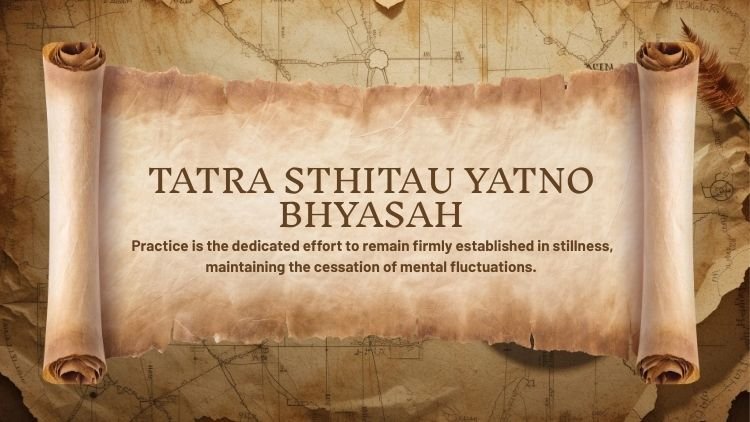Yoga Sutra 1.13: Tatra Sthitau Yatno Bhyasah

The Steady Effort That Anchors Us in Silence
Patanjali’s Yoga Sutras open with striking simplicity. In just a few verses, they map the yogic path, its challenges, and the tools to overcome them.
In Sutra 1.12, we learn of the two essential pillars of yoga:
“Tan nirodhah abhyasa vairagyabhyam ”
The fluctuations of the mind are calmed through practice (abhyasa) and detachment (vairagya).
Sutra 1.13 then clarifies what true practice means:
“Tatra sthitau yatno bhyasah ”
Practice is the steady, dedicated effort to remain firmly established in stillness.
At first glance, it may seem simple—practice is just effort. But the Sanskrit conveys much more. Here, abhyasah is not just “practice” in a general sense. It carries the weight of consistent, repeated effort—a discipline directed toward one aim: cultivating mental steadiness.
This sutra serves as both a definition and a gentle reminder. It tells us what authentic practice is, while cautioning us that stability of mind does not arrive by chance. It is the fruit of unwavering dedication, of showing up again and again, no matter how restless the mind becomes.
Translation of Yoga Sutra 1.13
Translation of Yoga Sutra 1.13
Sanskrit: तत्र स्थितौ यत्नोऽभ्यासः
Transliteration: tatra sthitau yatno bhyasah
Word-by-Word Meaning:
-
Tatra = there / in that state
-
Sthitau = stability, being firmly established
-
Yatna = effort, disciplined endeavor
-
Abhyasa = practice, repeated application
Translation:
Practice is the dedicated effort to remain firmly established in stillness, maintaining the cessation of mental fluctuations.
Commentaries Through Time
Vyāsa’s Perspective
Vyāsa highlights that practice here is not mere repetition—it must be directed toward cultivating mental stability. Without a clear goal, repetition becomes meaningless. One may continue with breathing exercises, meditation techniques, or postures, yet never touch inner peace unless the effort is consciously aligned with steadiness of mind.
Swami Vivekananda
Swami Vivekananda reminds us that abhyāsa means perseverance: “Practice is the ongoing effort to keep the mind steady.” He cautions that when discipline lacks consistency, it easily slips into shallow habit rather than true transformation.
Swami Satchidananda
For Satchidananda, abhyāsaḥ is the steady, persistent effort that continually returns the practitioner to their chosen technique—whether meditation, breath awareness, or chanting. He stresses that consistency outweighs intensity: it is the regular rhythm of practice that shapes the mind.
Swami Hariharananda Aranya
Aranya interprets this sutra as a continuation of 1.12, emphasizing that practice is not limited to outer actions. It also requires the conscious effort to calm the wandering mind and anchor it in stillness.
I.K. Taimni
In The Science of Yoga, Taimni describes abhyāsaḥ as the process of “digging one well deep enough to find water,” instead of scattering energy across many shallow pursuits. For him, the sutra points to willful endurance—sustained effort directed toward a single, transformative aim.
How the sutra is applied in practical situations: Examples
The Handstand Student
A yoga student spends months trying to master the handstand. In every class, she kicks up, tumbles down, and tries again. At first, she thinks success will come only when she finally balances. But the real breakthrough dawns when she realizes that practice is not about the perfect handstand—it’s about showing up, falling, and returning with steady effort. The handstand becomes just a side effect; her true abhyāsaḥ is the willingness to keep coming back.
The Meditator with Racing Thoughts
A beginner in meditation struggles with a restless mind. Thoughts pull her in every direction, and frustration builds. Her teacher gently reminds her: “Each time you notice your mind has wandered and you return—that is practice. That is abhyāsaḥ.” The effort lies not in resisting thoughts, but in the simple, steady act of returning to stillness again and again.
The Professional Seeking Success
A man pours all his energy into earning a promotion, convinced it will bring happiness. When he doesn’t get it, disappointment overwhelms him. Over time, through steady yoga practice, he learns that true effort is not about chasing outcomes but about remaining centered regardless of success or failure. That steady grounding—that is abhyāsaḥ.
The Psychology of 'Bhyāsaḥ
This sutra finds strong echoes in modern psychology:
-
Habit Formation
Lasting change is not born from one grand effort but from small, consistent actions repeated over time. Just as the sutra emphasizes steady effort, psychology shows us that habits, once cultivated, shape our identity and behavior. -
Mindfulness Training
Abhyāsaḥ aligns closely with mindfulness practices. Each time the mind wanders and is gently brought back to the present, the “muscle” of attention grows stronger. It is this repeated return, not perfection, that develops clarity and calm. -
Resilience
In education, athletics, or therapy, the key to success is consistency. The sutra reflects this timeless truth: progress is not measured by speed but by persistence. Perseverance anchors transformation.
On the Mat: 'Bhyāsaḥ in Yoga Practice
-
Asana (Postures)
The true practice is not in perfecting the shape of the pose, but in maintaining a steady state of mind within it. Each breath is an invitation to return to stillness, no matter how the body wavers. -
Pranayama (Breathwork)
The essence of breathwork is not about holding the breath longer, but about gently guiding the mind back to the rhythm of the breath whenever it drifts away. -
Meditation
Here, abhyāsaḥ is the act of returning—again and again—to the chosen point of focus, whether it is the mantra, the breath, or pure silence. The wandering is natural; the return is the practice.
Off the Mat: 'Bhyāsaḥ in Daily Life
In Relationships
Practice is found in the pause—choosing to breathe and respond with steadiness instead of reacting impulsively.
At Work
Effort is not only about completing tasks, but about doing them with clarity, presence, and balance.
In Stress
True practice is the habit of returning to calm—whether through a mindful breath, a mantra, or a simple pause. Each return strengthens resilience.
This sutra reminds us that real transformation doesn’t come from occasional effort. It blossoms through consistency—showing up every day with purpose, patience, and steadiness.
Reflections for Modern Practitioners
-
Consistency Over Intensity
Ten minutes of daily meditation can be far more transformative than a single hour once a week. True growth comes from rhythm, not occasional bursts of effort. -
Effort Without Attachment
This sutra naturally pairs with vairāgya (detachment). Practice means showing up with steady effort—yet releasing the grip of expectation.
Conclusion
Yoga Sutra 1.13—tatra sthitau yatno-'bhyāsaḥ—may be deceptively brief, yet it carries immense practical wisdom.
It reminds us that yoga is not measured by dramatic achievements, but by the quiet, steady effort of returning to stillness. The phrase “steady effort” holds profound meaning here: true practice is not simply what we do outwardly, but what anchors and centers us within.
As Vyāsa observed long ago, and as modern teachers continue to affirm, the path of yoga is not walked through occasional leaps, but through continuous steps—taken with steadiness of heart and clarity of mind.
If Sutra 1.12 gifted us the twin wings of practice (abhyāsa) and detachment (vairāgya), Sutra 1.13 shows us how one wing moves—through quiet, repeated, and intentional effort to remain rooted in the Self.
So, each time you sit in meditation, each time you pause to breathe amidst chaos, each time you choose steadiness over reaction—you are living this sutra.
That is abhyasah. That is true practice.
What's Your Reaction?


























